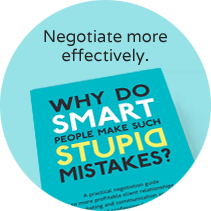Insights

The most expensive sales and negotiation mistakes that companies make
Chris Merrington of Spring 80:20 shares his advice on how you can avoid the most expensive negotiation mistakes. A new client had asked to see me. “Why did they need to see me” I asked myself. They’d been going for three years, grown revenue 30-40% each year and had a client list to die for. The CEO explained their success and said but “we’re not making any money, we under-priced our work to get the business” Can you help us? I specialise in helping companies be more profitable, negotiate more effectively and secure more sustainable business and unfortunately there’s no simple answer. It’s easy to set your prices under the rest of the market to win business but there are two major problems. You attract clients who are very focused just on price and secondly you set a precedent whereby increasing that price by more than a few % points will be very difficult.
For many reasons we don’t learn from our mistakes as much as we should. Smart people learn from their mistakes. But the really sharp ones learn from the mistakes of others. Then there’s the third group who keep making the same mistakes over again. Which are you?
In my work with companies and agencies I often see the same mistakes being made repeatedly. These mistakes are often really expensive financially.
THE SEVEN MISTAKES ARE INTER-CONNECTED
- Profitability
As a commercial company making a fair profit is a fundamental business goal. Revenue growth without profit growth is nuts. Often businesses are too focused on topline revenue growth at the expense of profit growth. Focus on long term sustainable profitable growth.
- Differentiation
What’s special about your brand? You might think you’re different but too often brands look the same to customers. Then in which case you’ll often be bought predominantly on price. What’s the real or perceived difference between you and competitors? Are the differences important to the customer? Are they real or perceived? Is it about being better? – not necessarily. Apparently in blind tastes tests Pepsi is preferred to Coca-Cola. Yet Coca-Cola sales dominate.
- Value
Not understanding your value is the next mistake. It is easy to become focused on the product or service rather than the result or impact of your brand. Customers want to buy the result of the brand. Value is in their eyes, not yours. We want to buy the ‘after’ or benefit of the product. I don’t want to buy cough mixture; I want to get rid of my cough. I don’t want to buy household content insurance, I want peace of mind. I don’t want to buy champagne, I want to celebrate. What’s your ‘afters’?
- Under-pricing
Under-pricing is a massive and costly mistake. By under-pricing we set a precedent with that customer going forward and it will be hard to increase our price with that same customer for subsequent work. Price is the No.1 factor to influence profitability. Price is A factor, it is rarely THE factor. Price may be No.3 or No.4 in the customer’s decision criteria. You need to understand what the other criteria are. You will need to be brave and make some courageous decisions. I recently spoke to an Anglian Window’s rep who within the first two minutes explained ‘we aren’t the cheapest’ and then went on to explain the benefits of using Anglian Windows convincing me that price wasn’t the only factor I should consider.
- Over-dependence
Over-dependence can be costly. If a customer represents more than around 15% of your business it reduces your confidence. There is then a danger that you avoid increasing your prices and avoid challenging the customer. Instead we play safe avoiding ‘rocking the boat’. Just because you’ve had a customer for 10 years is not a guarantee of the future. Most businesses typically lose 10-15% of their customers each year. I have seen too many businesses destroyed or decimated by the loss of one or two major customers. Hope is not a strategy! If Tesco is 30% of your business they obviously account for a substantial proportion of your sales but over-dependence takes away your ability to say ‘no’. For many businesses their biggest customer is often not their most profitable.
- Being ‘busy’
The disease of ‘busy-ness’ is endemic. Everyone is so busy, but are they effective and productive? The risk is we lurch from meeting to meeting, crisis to crisis. Too often we don’t take time to stop, think and plan. “We’re too busy chasing chickens to mend the fence”. Studies show we are at greater risk of burnout than ever before. Because of our busy-ness we then make a secondary mistake of short-termism. We become too focused on today and not enough on tomorrow. Of course hitting our current sales target is vital but not at the expense of the future. Don’t ‘mortgage’ the future for the sake of today. Eventually that credit card bill will need to be paid off!
- Ideal customers
Who is your ideal customer? If you are a premium brand then don’t chase customers who simply want a cheap price. Waitrose is clear who their customers are and don’t chase after Lidl customers. Many businesses have lost their focus on who their ideal customer is in a drive to grow overall sales. Blackberry was the business person’s mobile phone. They then pursued the youth market and lost their way falling between a rock and a hard place. I was a strong Blackberry advocate for years but then switched to an iPhone (with trepidation which lasted only a few hours) I am now an iPhone advocate and can’t envisage returning to Blackberry.
What mistakes are you making in your business? How much are those mistakes costing? Which mistakes do you plan to stop making?
Published in Journal of Revenue and Pricing Management
no comments
